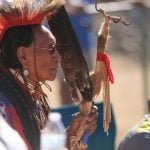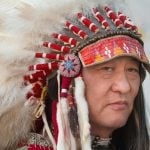From Boarding School to University
When the English-speaking Europeans began their invasion of North America, they viewed Indians as “savage,” “wild,” and “barbaric.” These English-speaking Europeans viewed themselves as superior to Indians in all ways and were often astounded to find that most Indians did not want to become like them. During the nineteenth and much of the twentieth centuries, the official education policies regarding Indians called for their assimilation into American culture. Assimilation called for Indians: (1) to speak English (preferable as their only language); (2) to be Christian (preferably Protestant); (3) to wear American style clothes; (4) to wear their hair in American fashion; (5) to live in American-style houses; and (5) to work in a cash-based economy (preferably at the low end of the economic scale).
Government educators felt that the best way to assimilate Indians was to focus on the children. If children could be removed from their homes, thus removing them from the “savage” influences of their language, religion, and community, and place them in boarding schools run by the obviously “superior” Americans, then assimilation could be accomplished. This was the philosophical and pedagogical foundation of the American Indian boarding school.
Since the federal government, and perhaps the American people, didn’t want to spend very much money for Indian education, the boarding schools were expected to be relatively self-sufficient. The students, often under the guise of “industrial education”, served as an unpaid labor pool to provide cleaning, cooking, sewing, farming, dairying, and other services. Since the American educators believed that hard work shaped character, they had justification for not paying students for their work.
Ultimately, the boarding schools were intended to destroy tribal identity. In its place, students were to gain racial awareness. American society is racist and Indians are viewed as a single racial group rather than several hundred distinct tribal or cultural entities. Boarding school students began to view themselves as Indians-a racial group-rather than as tribal members.

The Haskell Indian School (also known as the Haskell Institute, shown above) was established in 1884 in Lawrence, Kansas as one of the select schools in the Indian school system. Unlike many of the boarding schools in the system, it offered training beyond the standard eight-year program.
Like the other boarding schools of this era, Haskell trained boys for a number of trades, including tailoring, wagon making, blacksmithing, harness making, shoe making, painting, and farming. The girls were trained in cooking, sewing, and homemaking. The school had its own farm which was worked by the students and which provided the school with much of its food.
Initially, the school had 22 students, but the enrollment increased to 400 within one semester. While the school was initially named the United States Indian Industrial Training School, it was renamed the Haskell Institute in 1887 to honor Dudley Haskell, the U.S. Representative responsible for bringing the school to Lawrence.
By 1894, the school had 606 students from 36 states. At this time, a normal school was added because teachers were needed in the home communities of the students. In 1895, a commercial department was opened with five typewriters. The first touch-typing class in Kansas seems to have been taught at Haskell.
In a 1903 address to the National Education Association, the superintendent of the Haskell Indian School claimed:
“A really civilized people cannot be found in the world except where the Bible has been sent and the gospel taught; hence we believe that the Indians must have, as an essential part of their education, Christian training.”
In 1904, Haskell sent a delegation of students to the Louisiana Purchase Exposition in St. Louis. Living in the Model Indian School built by the federal government, the boys from Haskell demonstrated building wagons and blacksmithing skills while the girls demonstrated the domestic arts of sewing, tailoring, and millinery.
While many people would like to believe that the Indian students easily adapted to the foreign way of life in the boarding schools, this was not really the case. The fact that most of the boarding schools had both cemeteries for the students who died while attending and jails for holding those who were rebellious implies that life at the schools was not always easy.
In 1919, the students at the Haskell Indian School staged a rebellion. The students cut power to the campus just prior to an evening assembly. The students smashed light fixtures, looted the food supply, and rang the school bell. Following the rebellion nine students, four boys and five girls, were expelled.
For many of the Indian boarding schools, athletics were viewed as very important. Indian athletes competed against non-Indian athletes in many different venues. For example, in 1925 there was a football game between the American Indian Haskell Institute and the Jesuit Gonzaga College held in conjunction with the Northwest Indian Congress meeting in Spokane, Washington.
In 1926, thousands of people from many different tribes gathered to dedicate the new football stadium at the Haskell Indian School. The ceremonies included dances in which Sugar Brown, a four-year-old Otoe, was one of the featured dancers. A forty-member Blackfoot dance group which was promoting Glacier National Park, also performed. Indians dancers from 70 tribes participated in dance contests. Among those attending the dedication was Senator Charles Curtis (Kaw) who would later become Vice President. Some historians feel that this event marks the start of the modern powwow on the Southern Plains. It was not, of course, called a powwow at the time, but was considered a gathering.
A free buffalo bar-b-que was provided for the Indian participants. Four buffalo were purchased from the Rainy Mountain Game Reserve in Oklahoma. Many of the Indians in attendance had not eaten buffalo before.
From the 1900s to the 1930s, the Haskell football team played schools such as Harvard, Yale, Brown, Texas A&M, and other universities. In 1931, however, the school superintendent shifted from playing colleges to playing high schools. Football was dropped after the 1931 season and did not resume again until 2000.

The 1914 football team is shown above.
In 1933, Henry Roe Cloud (Winnebago) became the superintendent of the Haskell Institute, which was the largest American Indian high school in the country at this time. He was the first full-blood Indian to hold this position.

Henry Roe Cloud is shown above.
One of Roe Cloud’s assignments at Haskell was to investigate the Athletic Association. The school had a huge and heavily mortgaged stadium. The Association had been active in getting contributions from oil-rich Indians, particularly children who had corrupt non-Indian guardians. While some of this money had helped finance the stadium, much of the money was unaccounted for. Roe Cloud fired the football coach.
Roe Cloud began to transform the school from one in which the primary emphasis had been on vocational training, athletics, and military instruction, to a school that would function as a leadership and cultural activism training center.
In 1965, Haskell graduated its last high school class. In 1970 the school became the Haskell Indian Junior College. By 1988, planning had begun to transform the school from a Junior College into a baccalaureate degree-granting institution. In 1993 it became the Haskell Indian Nations University and offered a four-year elementary education teacher training program. In 1998, Haskell began offering degrees in American Indian Studies, Business Administration, and Environmental Sciences.
In 2002, the Cultural Center and Museum opened on the campus of the Haskell Institute. The center features a permanent exhibit Honoring Our Children Through Seasons of Sacrifice, Survival, Change, and Celebration. Among the many artifacts from the school’s past on display is a heavy iron lock and key for the school jail, which was used for holding unruly students
The university’s current vision statement:
Haskell Indian Nations University, the premier national intertribal university, empowers American Indian and Alaska Native scholars for leadership and service to sovereign first nations and the world by virtue of its excellent academic programs and research, creative activities, and culturally diverse student experiences.
The university’s current mission statement:
The mission of Haskell Indian Nations University, a land grant institution, is to serve members of federally recognized American Indian and Alaska Native nations as authorized by Congress and in partial fulfillment of treaty and trust obligations. With student learning as its focus, Haskell embraces the principles of sovereignty and self-determination through a culturally based holistic lifelong learning environment that promotes and upholds respect, rights, and responsibility.



